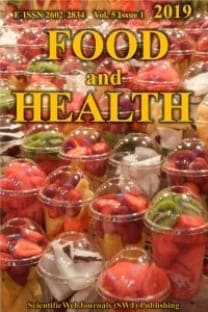Effect of black carrot (Daucus carota L.) pomace in cake and cookie formulations as a functional ingredient on sensory analysis
In this study, it was aimed to determine the properties of the black carrot pomace and its use in pastries. For this purpose, black carrot pomace was dried at 150ºC by using drum drier. Dietary fiber (64.93 %), total sugar (1.16 %), fat (1.60 %), protein (8.82 %), anthocyanins (0.21 mg/g) and total phenolic substances (2.30 mg/g) of the black carrot pomace were determined. The functional properties of the carrot pomace such as water retention capacity (1.53 g/g), swelling (1.59 mL/g), alcohol insoluble residue (737.5 g/kg) and emulsion capacity (30.64 mL/g) were calculated. Dried pomace was used at three different levels in modified cookie and cake formulations. Ranking test was applied for the sensory evaluation of each derived formulations. The results of the sensory analysis showed that the use of black carrot pomace in cookie formulations was more suitable and more preferred.
___
Akhtar, S., Rauf, A., Imran, M., Qamar, M. Riaz, M., Mubarak, M. (2017). Black carrot (Daucus carota L.), dietary and health promoting perspectives of its polyphenols: A review. Trends in Food Science & Technology, 66, 36-47. https://doi.org/10.1016/j.tifs.2017.05.004Altuğ, T., Elmacı, Y. (2005). Duyusal test teknikleri, Sidas Medya, ISBN: 9789944566087.
AOAC International (1990). Invert sugar in sugars and syrups. Lane-eynon (Standard No. 923.09-1923)
AOAC International (1994). Total, soluble, and insoluble dietary fiber (Standard No. 991.43-1994)
AOAC International (1995). Total Kjehldahl Nitrogen Fruits (Standard No. 920.152-1995)
AOAC International (1995). Ash of animal feed (Standard No. 942.05-1995)
Baltacıoğlu H., Baltacıoğlu C., Tangüler H. (2019). Effect of waste fermented carrot powder addition on quality of biscuits. Turkish Journal of Agriculture-Food Science and Technology, 7(9), 1237-1244. https://doi.org/10.24925/turjaf.v7i9.1237-1244.2759
Canett Romero, R., Ledesma Osuna, A.I., Robles Sánchez, R.M., Morales Castro, R., Leon-Martinez, L., Leon-Galvez, R. (2004). Characterization of cookies made with deseeded grape pomace. Archivos Latinoamericanos de Nutrición, 54(1), 93-99.
Carson, K.J., Collins, J.L., Penfield, M.P. (1994). Unrefined, dried apple pomace as a potential food ingredient. Journal of Food Science, 59(6), 1213-1215. https://doi.org/10.1111/j.1365-2621.1994.tb14679.x
Chau, F., Chen, C.H., Lee, M.H. (2004). Comparison of the characteristics, functional properties, and in vitro hypoglycemic effects of various carrot insoluble fiber-rich fractions, LWT – Food Science and Technology, 37, 155-160. https://doi.org/10.1016/j.lwt.2003.08.001
Constenla, D., Ponce, A.G., Lozano, J.E. (2002). Effect of Pomace Drying on Apple Pectin. LWT – Food Science and Technology, 35, 216-221. https://doi.org/10.1006/fstl.2001.0841
Food and Agriculture Organization (1986). Manuals of Food Quality Control. 7. Food Analysis: General Techniques. Additives, contaminants and composition. FAO Food and Nutrition Paper Rome. 14/7, 212-213. Retrieved from: http://www.fao.org/3/AM808E/AM808E.pdf
Figuerola F., Hurtado M.L., Estevez A.M., Chielle I., Asenjo F. (2005). Fiber concentrates from apple pomace and citrus peel as potential fiber sources for food enrichment. Food Chemistry, 91, 395-401. https://doi.org/10.1016/j.foodchem.2004.04.036
Fuleki, T., Francis, F.J. (1968). Quantitative methods for anthocyanins. 2- Determination of total anthocyanin and degradation index for cranberry juice, Journal of Food Science, 33, 78-83. https://doi.org/10.1111/j.1365-2621.1968.tb00888.x
Giusti, M.M., Wrolstad, R.E. (2003). Acylated anthocyanins from edible sources and their applications in food systems. Biochemical Engineering Journal, 14, 217-225. https://doi.org/10.1016/S1369-703X(02)00221-8
International Standards Organisation (2011). Sensory Analysis-Methodology-Method of Investigating Sensitivity of Taste (Standard No. 3972) Retrieved from: https://www.iso.org/standard/50110.html
Kamiloğlu, S., Özkan, G., Işık, H., Horoz, Ö., Van Camp, J., Çapanoğlu, E. (2017). Black carrot pomace as a source of polyphenols for enhancing the nutritional value of cake: An in vitro digestion study with a standardized static model. LWT – Food Science and Technology, 77, 475-481. https://doi.org/10.1016/j.lwt.2016.12.002
Keskin, M., Güçlü, G., Şekerli, Y.E., Soysal, Y., Selli, S., Kelebek, H. (2021). Comparative assessment of volatile and phenolic profiles of fresh black carrot (Daucus carota L.) and powders prepared by three drying methods. Scientia Horticulturae, 287, 110256. https://doi.org/10.1016/j.scienta.2021.110256
Nawirska, A., Kwaśniewska, M. (2005). Dietary fibre fractions from fruit and vegetable processing waste. Food Chemistry, 91, 221-225. https://doi.org/10.1016/j.foodchem.2003.10.005
Okezie, B.O., Bello, A.B. (1988). Physicochemical and functional properties of winged bean flour and isolate compared with soy isolate. Journal of Food Science, 53(2), 450-454. https://doi.org/10.1111/j.1365-2621.1988.tb07728.x
Pagan, J. Ibarza A., Llorcab, M., Pagan, A., Barbosa-Canovasc, G.V. (2001). Extraction and Characterization of Pectin from Stored Peach Pomace, Food Research International, 34, 605-612. https://doi.org/10.1016/S0963-9969(01)00078-3
Pandey, P., Grover, K., Dhillon, T.S., Kaur, A., Javed, M. (2021). Evaluation of polyphenols enriched dairy products developed by incorporating black carrot (Daucus carota L.) concentrate. Heliyon, 7, e06880. https://doi.org/10.1016/j.heliyon.2021.e06880
Robertson, J.A., De Monredon, F.D., Dysseler, P., Guillon, F., Amado, R., Thibault, J.F. (2000). Hydration properties of dietary fibre and resistant starch: A uropean collaborative study. LWT – Food Science and Technology, 33, 72-79. https://doi.org/10.1006/fstl.1999.0595
Schieber, A., Stintzig, F.C., Carle, R. (2001). By-products of plant food processing as a source of functional compounds – recent developments, Trends in Food Science & Technology, 12, 401-413. https://doi.org/10.1016/S0924-2244(02)00012-2
Stoll, T., Schweiggert, U., Schieber, A., Carle, R. (2003). Process for the recovery of a carotene-rich functional food ingredient from carrot pomace by enzymatic liquefaction. Innovative Food Science and Emerging Technologies, 4, 415-423. https://doi.org/10.1016/S1466-8564(03)00060-2
Vinson J.A., Dabbagh Y.A., Mamdouh M.S., Jang J. (1995). Plant flavonoids. Especially tea flavonoids are powerful antioxidants using an in vitro oxidation model for heart disease. Journal of Agricultural and Food Chemistry, 43, 2800-2802. https://doi.org/10.1021/jf00059a005
- ISSN: 2602-2834
- Yayın Aralığı: Yılda 4 Sayı
- Başlangıç: 2018
- Yayıncı: ScientificWebJournals (SWJ) Özkan Özden
Sayıdaki Diğer Makaleler
Evaluation of prebiotic, probiotic, and synbiotic potentials of microalgae
Özge Kahraman ILIKKAN, Elif BAĞDAT, Dilek YALÇIN
Feride AYYILDIZ, Merve Şeyda KARAÇİL ERMUMCU
Comparison of total phenolic contents and antioxidant activities of propolis in different solvents
Tuğba Nigar BOZKUŞ, Orhan DEGER
Makroalglerin mineral içeriği ve insan sağlığı için kullanım olanakları
Sevim POLAT, Abdurrahman POLAT
Gıda ve Yem için Hızlı Alarm Sistemi’nde yer alan çevresel kirletici bildirimleri
Aslı YORULMAZ, Derya DENİZ ŞİRİNYILDIZ, Nursevim ÇİFTÇİ, Şule KARADENİZ
EVREN GÖLGE, Gülden OVA, Kemal KEMAHLIOĞLU, Kemal DEMİRBAĞ
Nermin BERİK, Hasan Basri ORMANCI, Ekrem Cem ÇANKIRILIGİL, Akın AKYILDIZ
